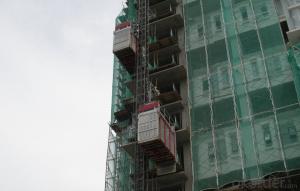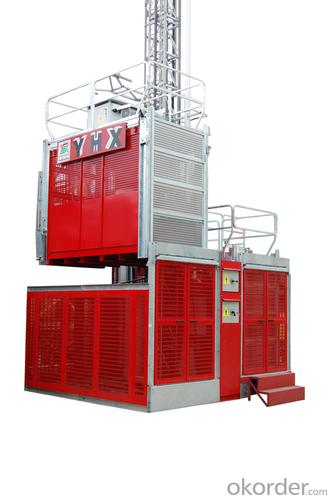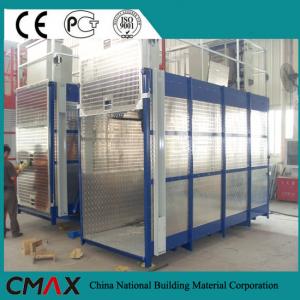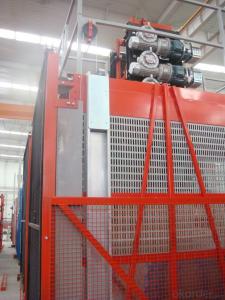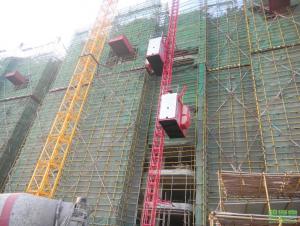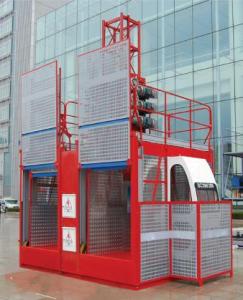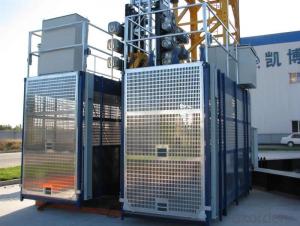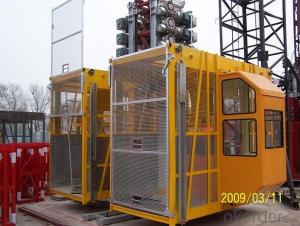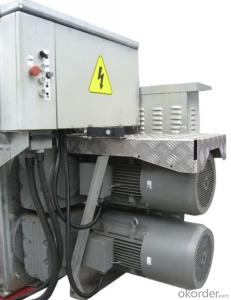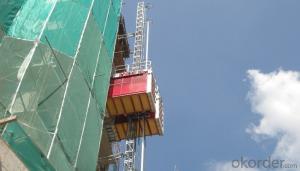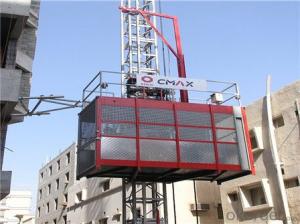YHX Building Hoist SC150/150
- Loading Port:
- Guangzhou
- Payment Terms:
- TT or LC
- Min Order Qty:
- -
- Supply Capability:
- 40 unit/month
OKorder Service Pledge
OKorder Financial Service
You Might Also Like
Brief Description of Curve Hoist:
Application: for power plant and curved surface Condition: New Rated Loading Capacity: 1.5T
Lifting Speed: 0-33m/Min Motor Power: 2x11KW Inverter: China Brand or Siemens, Schneider
Mast Section Size: 650x650x1508mm Diameter of Steel Pipe: 76mm Thickness of Pipe: 4.5mm
Remarks for the construction hoist
1. The recommended cage dimension: 2.0x1.0x2.5m. We can also manufacture cages of other size according to customers' requirement.
2. The cage and door material can be aluminum molded board, punched-plate, figured aluminum board or other type according to your requirement
3. The mast and the tie-in surface can adopt paint-spray or hot galvanizing processing.
4. Both domestic and imported driving system are available
Pictures of Our Curved Building Hoist in Construction Site:
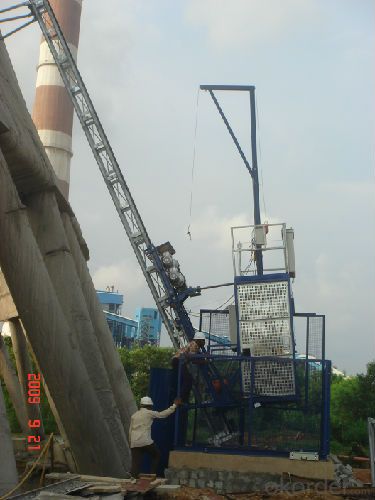
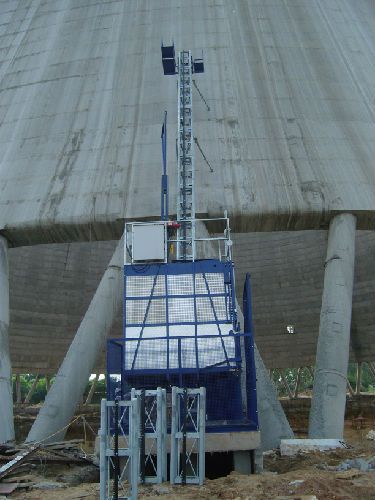
FAQ
Q: What is the Advantage of CMAX construction hoist?
A: CNBM is China-owned Manufacturer of Industrial Equipment and Building Material. We have been listed in Globale Fortune 500 since 2011. CMAX is a trustworthy brand.
Q: How do we define construction hoist by model?
A:Take SCQ150/150 as an example, "SC" means construction hoist with rack and pinion. "Q" means curved. "150/150" means it is double cage hoist and max loading capacity is 1500kg. "SCQ150" means rack and pinion curved construction hoist. single cage and max loading capacity is 1500kg.
Q: What is your aftersales service policy?
A: Our technician can be sent to help supervise and guide worker for the hoist erection. And also give some training about the maintainance of construction hoist. The cost of the ticket, accommodation and allowance per person per day is USD100 is paid by customer.
- Q: This question asks for the method to adjust the tension of ropes or cables in lifting equipment such as a building hoist.
- <p>Adjusting the tension on ropes or cables in lifting equipment like a building hoist involves several steps. First, ensure the equipment is turned off and secured to prevent any accidents. Then, locate the tensioning mechanism, which could be a ratchet, turnbuckle, or a similar device. Gradually adjust the mechanism to tighten or loosen the cable as needed. Use a tension meter to measure the tension and ensure it meets the manufacturer's specifications. Regularly inspect the cables for wear and damage, and replace them if necessary. Always follow the equipment's manual for specific instructions and safety guidelines.</p>
- Q: Construction elevator positioning should consider which problems
- The construction elevator is short for construction. It is an important equipment in high-rise building construction, and construction site accident hazards easily, because it can cause many major accidents, injuries in the inspection should be listed as a key to check the content. Based on past accidents and on-site inspections, we often find topics that we think should be examined in a critical area
- Q: This question asks whether building hoists can be used in both indoor and outdoor environments.
- <p>Building hoists can be used both indoors and outdoors, but their usage depends on the specific type and design of the hoist. Material hoists, for instance, are often used outdoors in construction sites to lift materials vertically. On the other hand, dumbwaiters are hoists designed for indoor use, typically to transport goods between floors in buildings. It's important to ensure that the hoist is suitable for the environment in which it will be used, considering factors such as weather conditions, building structure, and safety regulations.</p>
- Q: This question asks for the distinctions between two types of construction equipment: a building hoist and a lifting platform.
- <p>A building hoist, also known as a construction hoist, is a temporary elevator used in the construction of high-rise buildings to transport workers, materials, and equipment up and down the building. It is typically installed on the exterior of the building and is designed for vertical transportation. On the other hand, a lifting platform is a type of aerial work platform that can be either mobile or stationary and is used to lift workers and tools to a specific height for maintenance, repair, or construction tasks. Lifting platforms are often used for outdoor tasks and can be mobile, allowing them to be moved around a worksite as needed. The main difference lies in their application: building hoists are for vertical transport within a structure, while lifting platforms provide height access for a variety of tasks.</p>
- Q: Is it possible to use a building hoist to lift multiple items simultaneously?
- <p>Yes, a building hoist can be used for lifting multiple objects at once, provided that the combined weight of the objects does not exceed the hoist's load capacity. It's important to ensure that the hoist is designed for such use and that safety precautions are strictly followed to prevent accidents. The objects should be secured properly to avoid any shifting during the lift, and the operation should be conducted by trained personnel to maintain safety standards.</p>
- Q: What's going on with the decline in construction lift
- Check whether the brake contactor and normal, contactor adhesion conditions will decline, brake pads have the problem not only rise to fall, fall in the same slide. If the contactor is ok, you can see that there is a groove on the brake pad, and it is only replaced if the brake is not damaged, such as cracking. If it's a frequency conversion elevator, if you're down, see if the converter has any fault code, if you have a consulting manufacturer. The assumption is that the anchuan frequency converter, which may be a real SE failure, means that the timing error is not normal for controlling the contact of the receiver.
- Q: Is it possible to repair or replace a hydraulic pump used in a building hoist system?
- <p>Yes, a hydraulic pump used in a building hoist can be repaired or replaced. If the pump is damaged or worn out, it can be serviced or repaired by professionals who specialize in hydraulic systems. If the damage is beyond repair, a new pump can be sourced and installed to ensure the hoist operates safely and efficiently. Regular maintenance and inspection are crucial to prevent major issues and to extend the life of the hydraulic pump.</p>
- Q: This question asks for an explanation of the different types of building hoists used in construction.
- <p>Building hoists, also known as construction hoists or material hoists, are essential for moving materials and personnel in high-rise construction projects. The main types include: 1. <strong>Freestanding Hoists</strong>: These do not require a building structure for support and are self-supporting. 2. <strong>Cladding Hoists</strong>: Attached to the building's facade, used for moving materials during cladding work. 3. <strong>Personnel Hoists</strong>: Specifically designed for transporting workers, ensuring safety with features like cages and safety devices. 4. <strong>Material Hoists</strong>: Built to transport heavy construction materials and are robust and durable. 5. <strong>Electric Hoists</strong>: Operated by electricity, offering precise control and energy efficiency. 6. <strong>Hydraulic Hoists</strong>: Utilize hydraulic systems for lifting, known for their smooth operation and heavy load capacity. Each type serves a specific purpose and is chosen based on the project's requirements and the stage of construction.</p>
- Q: This question asks for an explanation of the functioning of hydraulic cylinders in lifting equipment.
- <p>Hydraulic cylinders in lifting equipment operate by converting hydraulic pressure into linear mechanical motion. They consist of a cylinder barrel, a piston, and a piston rod. When pressurized fluid is introduced into the cylinder, it pushes the piston, which in turn moves the piston rod. This movement is what lifts or moves the load. The force exerted by the piston is proportional to the pressure of the fluid and the area of the piston. The cylinder's design allows for controlled and precise lifting, making it ideal for heavy-duty applications where power and control are required.</p>
- Q: Is the construction elevator the same as the construction elevator
- Construction lifter is a kind of vertical lifting equipment standard name, generally refers to the SC model of the single or double hoisting cage hoisting cage, driven by gear and rack, (in recent years, there are many strands of wire rope drive), equipped with "" for safety device, can people goods with multiplication. The construction elevator is called a popular term, and the common site is called a rack elevator and a human cargo elevator, which means the same thing. Because this kind of product applies only to the construction site, it is very different from the common guest elevator. There are two other types of products that are common to this type of product, such as the SS single-column double cage (wire rope drive), which is called the material lift machine, which cannot be multiplied by people. There is also the WJ series double column single-cage (wire rope drive), which is called the dragon door frame, which is also not allowed to be passenger. Strictly speaking, the latter two kinds can't be called construction elevator, can be called so-and-so elevator. Above is a person's humble opinion, if be in and out, still hope the expert is correct!
Send your message to us
YHX Building Hoist SC150/150
- Loading Port:
- Guangzhou
- Payment Terms:
- TT or LC
- Min Order Qty:
- -
- Supply Capability:
- 40 unit/month
OKorder Service Pledge
OKorder Financial Service
Similar products
Hot products
Hot Searches
Related keywords

